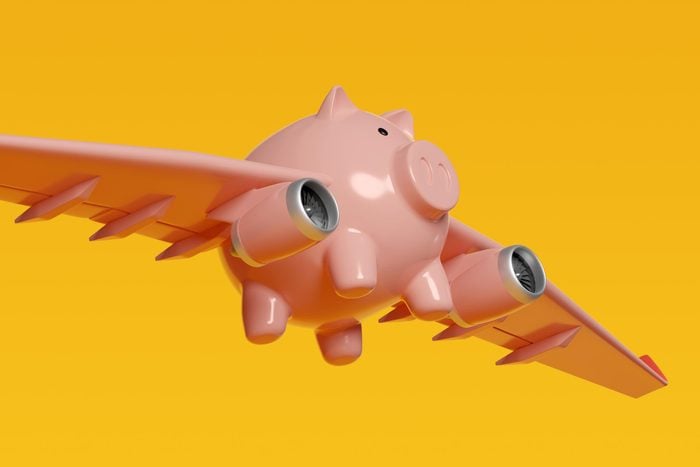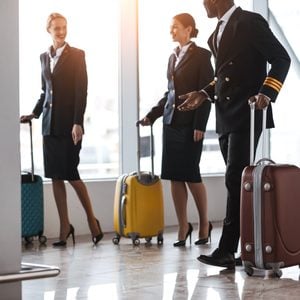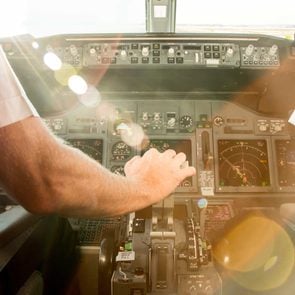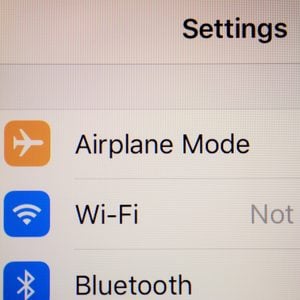5 Budget Airlines That Actually Get Great Reviews
Updated: Apr. 15, 2024

Save money on your next flight—and have more to spend at your destination—by traveling on a budget airline.
Now that most pandemic-related travel restrictions have been lifted, Americans are taking to the skies in record numbers. And while high demand means that some airlines are charging premium prices, there’s a trick to paying less for airfare: You can buy flight tickets for budget airlines.
You probably won’t get any of the niceties that legacy airlines like American, Delta, and United offer, and these airlines aren’t exactly known for stellar food, but it may not matter. After all, you can always bring food on the airplane.
Many people would prefer to soak up the luxury once they arrive at their destination, viewing an airplane as nothing more than a way to get from point A to point B safely and without too much inconvenience. If that’s your view, read on for insights into the budget airlines frequent flyers actually enjoy using. Then find out which ones have the best and worst airlines’ fees.
How can I get cheap airline tickets?
To start, forget the myth about buying on Tuesday or Wednesday. “There was a time and place when that was the case,” says Zach Griff, senior reporter for The Points Guy. But today, “the pricing algorithms have gotten so smart and refined that you can’t game them by buying on a certain day.”
There are, however, other tricks to paying less for airfare. For example, you might purchase an outgoing flight on one budget airline and a return flight on a different airline.
And here’s some airplane trivia for you: Traveling midweek is often less expensive than on other days. Since business travelers are usually willing to pay full fare to travel on Mondays and Fridays, and vacationers are eager to fly on weekends, the sweet spot for takeoff seems to be Tuesday through Thursday. Morning flights are also likely to be cheaper (and less prone to delays!), according to Lousson Smith, product operations specialist at Scott’s Cheap Flights, a membership service that alerts subscribers to flight deals.
He says it helps if you can be flexible on at least one of three important points: where you go, when you go, and when you book. If you can’t be flexible on the first two—say, you have a family wedding coming up—at least try to take advantage of the “Goldilocks window,” the prime time to schedule a trip. For domestic travel, book at least one to three months in advance; for international travel, the window expands to two to eight months in advance. “If your travel is during a peak season, like Christmas, add a couple of months on top of that,” Smith says.
Griff adds that using Google’s flight-search feature can save travelers some coin. “It uses historical fare data to predict whether your fare is low, medium, or high for a specific time period. It works for all domestic routes,” he says.
What is the most inexpensive airline?
No single airline is always the cheapest; it varies market by market. The only exception to this, says Smith, is newcomer Breeze Airways, which launched less than a year ago. “If Breeze is an option for you, it will be the cheapest,” he says.
That said, competition can drive down prices for the other airlines. “When Spirit or Frontier is in the mix, they have to compete with each other, so they’re going to fight for your business,” he says. “It really goes back and forth.”
Determining the best budget airlines for your travel needs may require a little math on your part. “On average, [ultra-low-cost] airlines like Spirit and Frontier are the cheapest on the fare level,” Griff says. But the prices each airline charges for various amenities (food, pillows and blankets, and Wi-Fi, for instance) differ, so it’s worth breaking out the calculator.
“If the flight is so cheap, it might work in your favor even if you need to check a bag,” Smith adds.
What is considered a budget airline?
There’s no strict definition of a budget airline, but experts agree that a central condition is the most obvious one: They charge a lower base fare than the legacy airlines. In a model known as unbundling, low-cost airlines add on fees for most of the perks that are included as part of the fare in legacy airlines: seat selection, carry-on bags, checked bags, snacks and beverages, and more.
“Since 2000, the Big Three have been losing more and more market share to these lower-cost airlines,” says Smith. As a result, he says, those legacy airlines have introduced “basic economy” to compete.
But price isn’t the only distinction between traditional and budget airlines. Griff says the structure of the airlines’ networks also differs. “Low-cost carriers don’t typically have hubs,” he says. “They fly mostly point to point.”
They’re usually in secondary markets, where business costs are lower for airlines and airports are easier and faster for travelers to navigate. Many budget airlines also have only one class of service, eliminating the first-, business-, and coach-class model.
Additionally, low-cost carriers often have only one type of aircraft in their fleet, making it less expensive to maintain and to train crew on. This often means their fleet is more modern than those serving legacy airlines.
And budget airlines “densify” their planes, Griff says. If you’ve ever flown on one of these carriers, you know the cost-saving trick well. The airline crams in so many people that the per-seat cost of operating the flight is much lower—but so is the comfort factor.
Beyond that, there’s some dispute as to what qualifies as a budget airline. Smith acknowledges that Southwest and JetBlue “started off as budget airlines, but now they are kind of the leading companies in the field.” Plus, they offer some perks, so he often makes a distinction between them and “ultra-low-cost carriers” like Spirit and Frontier.
Are budget airlines good?
If your top priority is saving money, then budget airlines can be a terrific option. “They are unlocking travel for people who might otherwise be unable to travel,” Griff says. But if you’re going to be unhappy in a narrow seat for a few hours, or you don’t want to bring your own food aboard, it might not be the best choice for you.
Some of the most common complaints travelers have with budget airlines are last-minute delays or outright cancellations with little to no warning, as well as difficulty getting refunds for unused tickets.
“Budget airlines have very trimmed-back flight schedules,” Smith explains. If a flight gets canceled, “they’re obligated to put you on a new flight, but if that’s not till Monday morning, you’re effectively stranded there until then.” In contrast, if a flight on one of the Big Three gets canceled, the airline probably has another flight later the same day.
Perhaps surprising to some travelers is that safety is not a concern on low-cost carriers, at least in the United States. All airlines must adhere to the same federal safety regulations.
Best budget airlines
Breeze Airways
“Breeze Airways is among the best. They are a small-budget airline founded by David Neeleman, the former CEO of JetBlue,” says Smith. Notably, Neeleman also founded or cofounded Morris Air, WestJet, and Azul Brazilian Airlines. “What separates Breeze from the pack is its commitment to only nonstop routes at low prices and its extensive and growing network of routes to underserved markets—while slowly peppering some bigger cities into the mix,” he explains.
Like most low-cost airlines, Breeze charges for checked bags at the lowest-tier levels, though one personal item is free for all tiers. (Tiers are Nice, Nicer, and Nicest.) There is no in-flight entertainment, but Wi-Fi (for purchase) is coming soon.
The airline does offer a few niceties: AC power and USB ports at every seat, bigger windows, and even LED mood lighting. Best of all, though, may be the lack of connecting flights.
Avelo Airlines
Avelo Airlines, like Breeze, lifted off during the pandemic with its inaugural flight in April 2021. In the year since, the ultra-low-cost carrier has ascended to high praise. Avelo’s flights do not traverse the continent but instead fly to 12 western and 13 eastern cities from headquarters on each coast (one in Burbank, California, and the other in New Haven, Connecticut).
Most flights are under two hours, making the cramped seating and tiny tray tables (too small for a laptop, according to one reviewer) bearable. Fees for carry-on and checked bags are reported to be lower than those on other airlines, and the company doesn’t charge cancellation or change fees. You can even go old-school and make reservations over the telephone for no added charge.
Spirit Airlines
Surprised Spirit made our list of the best? “Everyone wants to love to hate them, but they have buttoned up their operation after last year’s meltdown,” says Griff, referring to an 11-day period last summer when the airline canceled more than 2,800 flights, leaving passengers stranded for days. That’s not all. Frequent travelers have historically complained about lost luggage, poor customer service, and canceled flights.
But Griff says the ultra-low-cost airline has invested in a new fleet of planes, expanded its network (it now flies to 41 destinations from its base in Las Vegas), improved its reliability, and now offers onboard Wi-Fi for a very low cost. “They deserve an award for most-improved airline,” he says.
Earlier this year, Frontier announced it would purchase Spirit, in a move guaranteed to shake up the budget-travel category. But Griff says that since then, JetBlue has also bought Spirit, so “there’s a lot of change in the air.”
Southwest
With seat pitch (aka legroom) closely resembling what you’d find in economy class on a legacy airline, plus two free checked bags, a free carry-on, and free snacks and beverages, it’s hard to remember that Southwest is a budget airline at its roots. That’ll kick in, though, when it’s time to check in. Southwest assigns passengers to boarding groups based on when they checked in online; those in the first group have access to any seat on the plane, and those in subsequent groups have their pick of what’s left as they board. You won’t find power outlets at any of those seats either.
Still, its loyalty program wins high marks for no blackout dates and partnerships with certain hotels and rental car companies. The airline is also known for the humor that flight attendants insert into safety presentations, and it remains a perennial favorite among frequent flyers, winning 4.5 out of five stars from Tripadvisor reviewers. As for its operational meltdown over the 2022 holidays, Griff says the airline is working to address the root of the issue that caused it.
JetBlue
Once a favorite among budget travelers, JetBlue—which Griff describes as a hybrid between a true budget carrier and a full-service airline—has left some unhappy travelers in its contrails in the past year. The Wall Street Journal‘s annual ranking of domestic airlines placed JetBlue dead last in 2021, with the highest rate of extreme delays. It had the second fewest number of on-time arrivals, with only Allegiant Air doing worse. It also took the runner-up position for the amount of customer complaints, with only Spirit airlines faring worse.
Many reviewers still rank it highly, however, for food and beverage (those free blue Terra chips are still a customer favorite), in-flight entertainment (free Wi-Fi and seat-back TVs), and seat comfort. Its loyalty program is popular too, thanks to the ability to pool points with friends and family members, Smith says.
Sources:
- Zach Griff, senior reporter for The Points Guy
- Lousson Smith, product operations specialist at Scott’s Cheap Flights



